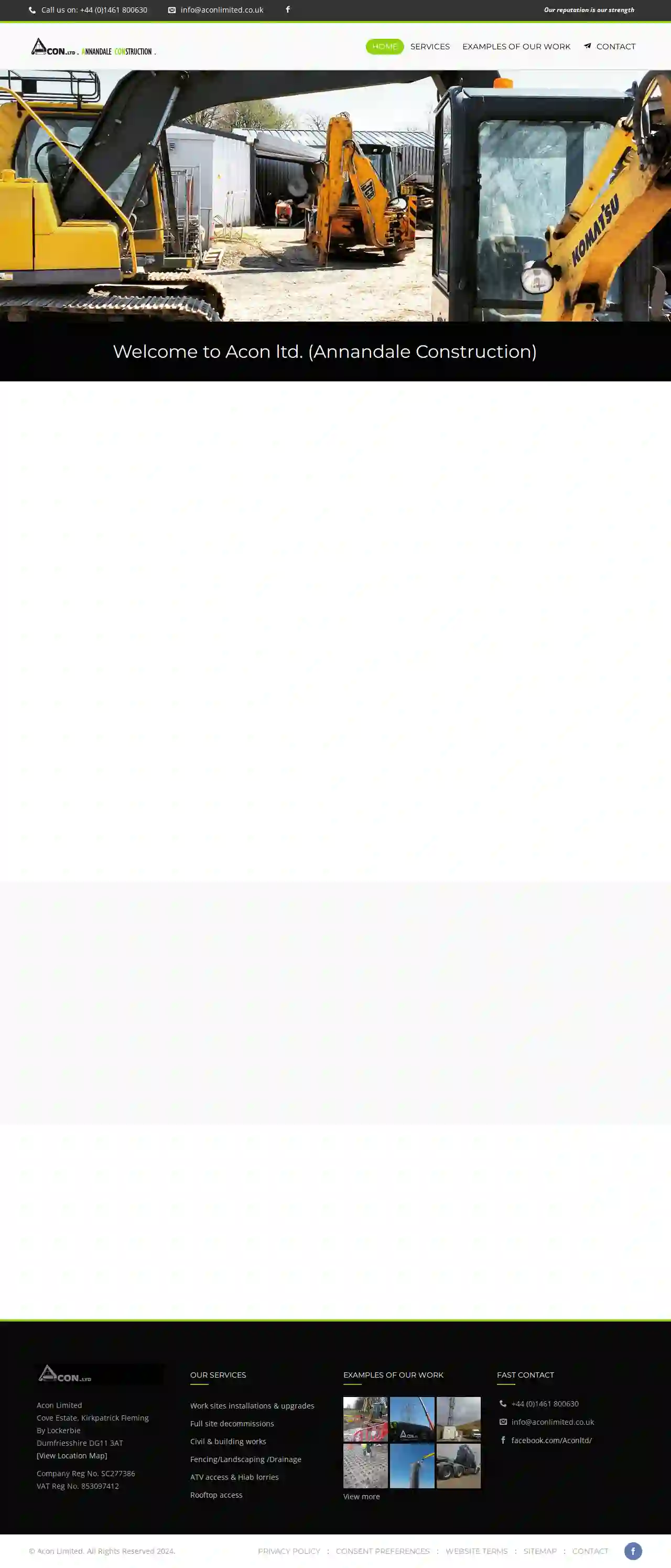Demolition Contractors Hornsea
Top Local Demolition Contractors in Hornsea
Receive 3 FREE Demo Contractors quotes for your project today! Compare profiles, reviews, accreditations, portfolio, etc... and choose the best service.

LC Plant Services LTD - Mobile Plant & Forklift Truck Repair
3.73 reviewsUnit 3PKP Trading Estate, Carr Wood Road, Unit 3PKP Trading EstateCarr Wood RoadCastleford West Yorkshire, Castleford, WF10 4SB, GBAbout LC Plant Services Ltd. Founded in 2014, LC Plant Services Ltd has become a strong team within the Construction Plant, Machinery & Material Handler sector. With our dedicated office & service team, we can assist you with all your machinery repair requirements. From site breakdowns to major overhauls, we can carry out anything you may require. We offer a dealership level of service, providing diagnostics, repairs, and honest advice across Yorkshire and the UK. We are Yorkshire's No. 1 choice for all Mobile & Construction Plant Machinery Repair & Maintenance with National coverage due to our ever-growing fleet of Service Engineers! LC Plant Services Ltd is a fully independent, professional mobile plant machinery, Quarry plant machinery, Construction plant, forklift truck & static plant maintenance repair & service company. We offer our customers a full-rounded service for all plant & machinery needs, from interim inspections, servicing, repairs, LOLER / PUWER Examinations, transport and plant hire, all at competitive prices. Based in Pontefract West Yorkshire, we offer reliable effective breakdown & major repair & servicing solutions throughout the Yorkshire & The Humber regions to all brands & models of 360 & 180 degree Excavators, Mini Diggers, Dumpers, Rollers, Loading shovels, Skidsteer loaders, Forklift trucks, Generators, Compressors & any other powered hydraulic equipment. Diesel engine diagnosis & repair specialist & auto electrics carried out. We can offer state-of-the-art Diagnostics + Remapping services to increase power levels & more. Our high level of experience guarantees customers minimal downtime due to our extensive knowledge of all aspects of machinery component diagnosis and repair. Fully LEEA accredited to carry out on-site Loler/Puwer thorough examinations to mobile plant, forklift trucks, HIABS, cranes, lifting equipment & static plant. Plant machinery & forklift truck transport specialists. Local or nationwide, site moves, machine recovery, general transport, please contact us for a competitive quote.
- Services
- Why Us?
- Accreditations
- Our Team
- Gallery
Get Quote
Hatfield's Equipment & Dedication Services, Inc.
4.220 reviewsPO Box 519, Annapolis Junction, 20701, GBHatfields Equipment and Dedication Services, Inc Hatfields Equipment and Dedication Services, Inc is a family-owned and operated business serving Anne Arundel County, Baltimore County, Southern Carroll County, Southern Frederick County, Howard County, and Montgomery County Maryland. We offer emergency service and free estimates for both residential customers and commercial businesses. Our Services Hatfields Septic offers a wide range of services to meet your needs, including: Septic Tank Pumping & Maintenance Septic Troubleshooting Septic System Installation & Repairs Certified to install Multiple BAT (Best Available Technology) Systems Certified (BAT) Norweco Inspections for yearly MDE (Maryland Department of Environment) requirements Drain fields Percolation / Perc Tests Water & Sewer Repairs / Installation Commercial Grease Trap Pumping Stormwater Management Services (SWM) Sewer & Storm Drain Cleaning, Maintenance, Repairs, Video Services Jetting & Vacuuming Test pitting for underground utilities Video Camera Pipe Inspections Bond Release Work Demolition of buildings, houses, sheds, anything you need to be torn down and hauled away External Sewer Grinder Pit Maintenance (E-ones) Carwash Pit / Recirculation Tank Cleaning / Maintenance
- Services
- Why Us?
- Gallery
Get Quote
MB Contracting
Yarmouth, 04097, GBExperience the Difference of Professional Excavation - Choose MB Contracting Unmatched Expertise and Precision for All Your Excavation Needs MB Contracting is a Local Grading Company Serving The Greater North Yarmouth, Maine Area At MB Contracting, we specialize in grading and construction site preparation, transforming raw land into functional spaces. From land clearing and demolition to significant landscape projects and erosion control, our excavating contractors are reliable and professional. We serve the greater North Yarmouth, Maine, area. Why Choose MB Contracting? Expertise Specialized knowledge and skills in precise digging, earthmoving, and site preparation. Advanced Equipment Utilization of state-of-the-art machinery for efficient and effective excavation services. Focus Adherence to strict safety measures, ensuring a secure work environment for all involved. Comprehensive Services Offering a range of services, including land clearing, demolition, and grading, for a one-stop solution to project needs.
- Services
- Why Us?
- Gallery
Get Quote
Acon limited
52 reviewsCove Estate, Kirkpatrick Fleming, Lockerbie, DG11 3AT, GBACON Ltd UK Based Acon limited operate in the Construction Industry and specialise in the Telecom Sector. The Telecom Sector continues to be at the epicentre for growth and development and here at Acon ltd we have become known and trusted Industry specialists. Acon ltd have become the go to provider for all our client's needs; from rooftop sites, to large scale greenfield sites, to basic street works. We have experience with any and all telecom sites either with new builds or decommissioning and all the steps in between.We have carried out the following services, from the Shetland Islands in the North to Portsmouth in the South: Telecoms industry specialists Excavations Drainage Access roads Steel fixings Concreting High Level Rope Access Rooftop Access ATV Access HGV Hiab plant Lorries- Lift & Shift Lightning Protection Through our sister company LPS (Lightning Protection Services) we can also offer a full range of lightning protection, high level access, rope access, steeplejack and earthing services. Telecom Sector Acon has gained a wealth of experience in the Telecom Sector on sites for all the network providers and continue to meet and exceed the requirements of our clients. Health & Safety All operatives are: CITB registered, trained in rooftop awareness, RF, Cable avoidance, MEWPS, First aid, Banks man slingers, Manual handling, Abrasive wheels ect. and are CSCS registered.
- Services
- Why Us?
- Gallery
Get Quote
Elvington Park Building Services Ltd
51 reviews60 Elvington Park, Elvington, York, YO41 4DW, GBWelcome to Elvington Park Building Services Limited Elvington Park Building Services is a family run building company based in Elvington, on the outskirts of York. We work with a range of clients from homeowners and commercial customers, to public sector and NGO's, across the North of England. Our team of highly experienced craftsmen and managers, along with our professional partners such as architects and surveyors, provide our clients with the highest standards of work. Our Services We offer a wide range of building services, including: Kitchens Bathrooms Extensions Joinery New build Open Plan and Outdoor Living Commercial Architects Our Experience With more than 30 years of experience behind us, Elvington Park Building Services is one of York's premier builders.
- Services
- Why Us?
- Testimonials
- Gallery
Get Quote
Lupin Project Group
100 Consilium PL Suite 200, Scarborough, M1H 3E3, GBLPG Delivers Lupin Project Group has successfully delivered some of the most complex construction projects. Diverse expertise in the areas of project management, site development, building layout and structural design has fortified and enhanced our core contract capabilities. Our work reflects extensive experience and dedication specifically in residential, commercial and industrial design. The materials and methods that we utilize ensure potential duplication is identified, managed and eliminated in our client’s best interest. LPG Relationship Lupin Project Group has spent years building successful relationships with our subcontractors and suppliers. The strength of these relationships allows us to confidently offer our clients the most efficient performance and reliable prices. LPG Dedication Lupin Project Group is dedicated to be the leading provider of high impact consulting services in structural design and project management services. We will serve customers in both the industrial and residential sectors by offering innovative, full-service solutions that positively impact the design and performance. LPG Logistic Being partnered with AT 6ix Logistic, offers a variety of trucks, trailers, different types and sizes. We will explore all opportunities to consolidate your shipments and give the best solution for your transportation needs. LPG Staffing Lupin Project Group firmly believes in adopting a tailored approach to meet temporary and permanent recruitment needs. We uphold the interest of our clients by finding skilled and proficient workers.
- Services
- Why Us?
- Gallery
Get Quote
PC Excavations Ltd
4.52 reviewsWest Moor Lane, Armthorpe, Doncaster, DN3 3EA, GBAbout PC Excavations With over 40 years of experience, PC Excavations is dedicated to providing high-quality services to all our clients in an efficient and professional manner. We offer a wide range of services to the construction industry, civil engineering, and associated industries. While PC Excavations is a relatively new company, we have a solid financial foundation and excellent relationships with local quarries and tips, backed by substantial credit facilities. Our Commitment We are committed to staying at the forefront of industry advancements, constantly investing in the latest technologies and equipment to ensure our clients benefit from time and cost savings. Our commitment to environmental responsibility is reflected in our strong and efficient environmental procedures, prioritizing recycling opportunities and minimizing waste. Our Clients We are proud to have worked with a diverse range of clients, including: Advanced Diesel Engineering Ltd Aggregates R Us Ltd Andy Collins Aggregates Ltd Askern UK Ltd Atala Forestry Group Ltd Balfour Beatty Cadman Constructions Ltd Carillion Close Building Services Ltd Danum Developments Ltd Doncaster Rugby Club ETL Ltd Hol-Tro Enterprises Ltd JJ Foods Ltd Laing O’Rourke Paragon Quality Foods Ltd Peel Airports Group Phoenix Developments Ltd PS Construction R Baystone & Son Ltd Stainforth Construction Ltd TR Fabrication Ltd Warwick Ward Machinery Ltd Westmoreland Group White Horse Contractors Winvic Construction Ltd Wisconco Ltd Yorkshire Aggregates Yorkshire Horticultural Ltd
- Services
- Why Us?
- Accreditations
- Gallery
Get Quote
York River Forestry & Environmental Services
544 reviewsYork, GBImplementing Effective Property and Forestry Solutions, To The Highest Standards of Practice. We are a forward-thinking small business. Founded by a Registered Professional Forester, guided by local experience and fuelled by a lifelong passion for Forestry and Environmental Management. We focus on providing a personalized service while building lasting client relationships. A superb customer experience is our guarantee!
- Services
- Why Us?
- Testimonials
- Gallery
Get Quote
Act Fast Waterproofing Corp.
4.964 reviewsToronto, GBAct Fast Waterproofing: Your Toronto Basement Waterproofing Experts Act Fast Waterproofing is your trusted partner for all your basement waterproofing and foundation repair needs in Toronto and the surrounding areas. We have over 25 years of experience in the industry, and our dedicated team is committed to providing you with the highest quality services and solutions. Our Mission Our mission is simple: to dry up your basement or crawlspace permanently. We understand the frustration and inconvenience that a wet basement can cause, and we are dedicated to providing you with a permanent solution. What We Offer We offer a wide range of basement waterproofing services in Toronto, including: Basement Lowering / Underpinning Control Mold Crack Injection Sealing Demolition and Excavation External Waterproofing Internal Waterproofing Masonry Services Sump Well & Pump Window Well Why Choose Act Fast Waterproofing? Here are just a few reasons why you should choose Act Fast Waterproofing: Experience: We have over 25 years of experience in the waterproofing and foundation repair business. Commitment: We are committed to solving all types of basement and crawl space water problems, as well as structural repair issues. Industry-Leading Warranty: All of our residential, multi-unit, commercial, and industrial waterproofing solutions carry a 25-year transferable warranty. Customer Satisfaction: Our clients rave about the proven superior methods that we use. Professional Team: Our employees are all highly trained and properly vetted. Get a Free Estimate Today! Don't let a wet basement ruin your home. Contact Act Fast Waterproofing today for a free estimate. We'll be happy to answer any questions you have and provide you with a customized solution.
- Services
- Why Us?
- Gallery
Get Quote
Jennings of Pudsey
Jennings of Pudsey Ltd, Pudsey, Leeds, Hutton Hall Farm, Greentop, LS28 8JW, GBBuilding our foundations on local trust and a commitment to providing the highest quality demolition services. Jennings of Pudsey are specialists in all aspects of residential, commercial and industrial demolition, project management and site coordination. Following over 50 years in business, we have built up a unique knowledge of demolition practices and techniques. Our fully qualified team of 20 demolition experts work tirelessly to deliver works safely, efficiently and to the highest possible specification. You will find us courteous, professional and highly knowledgeable on all aspects of demolition and deconstruction. We are happy to work as a primary contractor or sub-contractor and we can accommodate projects up to any size. In addition to our demolition and deconstruction services, we also offer the following services: Asbestos removal and disposal, emergency work, crushing services, site clearance and preparation, bulk excavation, and asset recovery. These are available as part of a larger demolition project or as standalone services to suit your needs. The Leeds Connection We mainly operate in Leeds and its surrounding areas. Founded in 1959, we have worked on over 300 demolition projects in Leeds. We’ve been around for so long that we were involved in the demolition of the Railway Bridge on Henshaw Lane in 1969 and the Quarry Hill housing complex in 1978. Our unique attachment to Leeds makes us the perfect demolition and excavation contractor for any business operating in the Leeds area.
- Services
- Why Us?
- Gallery
Get Quote
Over 13,059+ Excavation Pros onboarded
Our excavation experts operate in Hornsea and beyond!
ExcavationHQ has curated and vetted Top Excavation Businesses in and around Hornsea. Find a top & reliable business today.
Frequently Asked Questions About Demolition Contractors
- General Liability Insurance: Covers bodily injury or property damage to third parties caused by the contractor's negligence.
- Workers' Compensation Insurance: Provides benefits to workers injured on the job.
- Pollution Liability Insurance: Covers costs associated with environmental contamination caused by demolition activities.
- Professional Liability Insurance: Protects against claims of negligence or errors in professional services, such as demolition planning or consulting.
What is the importance of insurance in demolition projects?
What is asbestos abatement?
What is a demolition bond?
How do I find demolition contractors near me?
What is the importance of insurance in demolition projects?
- General Liability Insurance: Covers bodily injury or property damage to third parties caused by the contractor's negligence.
- Workers' Compensation Insurance: Provides benefits to workers injured on the job.
- Pollution Liability Insurance: Covers costs associated with environmental contamination caused by demolition activities.
- Professional Liability Insurance: Protects against claims of negligence or errors in professional services, such as demolition planning or consulting.